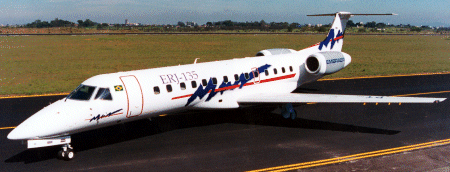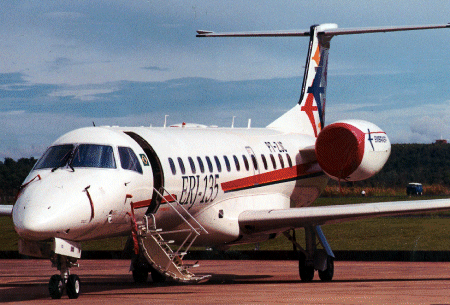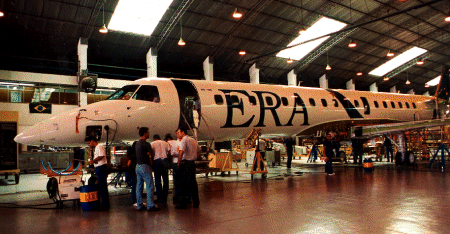Graham Warwick/WASHINGTON DC

It seems a simple, sensible approach: take a proven airframe, shorten the fuselage to produce a smaller aircraft, leave the rest unchanged, and avoid the time and cost of developing a new design. But surprisingly, not all such "shrunk" designs are as successful as the originals.
Embraer, however, looks set to repeat the success of its 50-seat regional jet, the ERJ-145, with its shrunk 37-seater, the ERJ-135. The Brazilian manufacturer already has orders and options for 309 ERJ-135s, to add to its tally of 461 commitments for the -145, and deliveries have yet to begin.
Shrunk aircraft are a challenge because cutting chunks out of the fuselage does not remove much weight or cost from the final product. Embraer has been able to reduce the price of the 37-seater relative to that of the 50-seater partly by minimising certification costs, but mainly by negotiating new contracts with its suppliers ,based on a larger production run.
The $300 million development cost of the ERJ-145 was intended to be amortised over 400 aircraft. Development of the ERJ-135 has cost a further $100 million, but added 500 aircraft to the expected production run. Including an increased estimate for the 50-seater, Embraer expects to produce 1,000 aircraft of both types. This has allowed the company to negotiate lower prices with its suppliers.
Although the aircraft are virtually identical, except in length, Embraer is able to sell the 37-seater for about $3.5 million less than the 50-seater. Reducing the ERJ-135's price was critical to its success because the aircraft competes directly against turboprops - even more than does the larger -145 - in the cost-conscious regional airliner market.
It took Embraer a long time to capitalise on the success of its EMB-120 Brasilia 30-seat regional turboprop by bringing a second product to the market. Its first attempt was a 19-seat turboprop, the CBA-123, a technical success which perished in the airline recession of the early 1990s.
The company's 50-seat regional jet project, then called the EMB-145, was unveiled in 1989, but a succession of redesigns and the prolonged privatisation of Embraer delayed the formal go-ahead to January 1992. First flight was in August 1995, leading to US certification and first deliveries in December 1996.
Launch of the ERJ-135 programme was announced in September 1997. As the aircraft are about 95% identical, the first two ERJ-145 prototypes were modified to act as the -135 flight test aircraft. First flight was in July 1998, and Embraer says the programme is on schedule for Brazilian and US certification in June. First deliveries are planned for July.

Original concept
Embraer's original concept for a regional jet was for an aircraft with turbofans mounted over a straight wing. This provided maximum commonality with the EMB-120, but not the desired performance. The final design, with a swept wing and tail-mounted engines, still allowed use of the 30-seater's nose and cabin cross-section, and proved to exceed the required performance.
To create the ERJ-145, Embraer essentially stretched the EMB-120 fuselage by 9.2m (30ft) and mounted it on a new wing. To create the ERJ-135, the company has in effect removed two plugs inserted in the -145 fuselage and substituted shorter ones, reducing length by 3.5m. Cabin width, at 2.1m, is identical to that of the EMB-120, but height has been increased to 1.82m by dropping the aisle by 60mm.
The ERJ-135 cabin provides three-abreast seating for 37 passengers, compared with 30 in the EMB-120 and 50 in the ERJ-145. Overhead bins, with a total capacity of 0.99m3 (34.8ft3), are provided on the right side of the fuselage only, above the double seats. In common with the 50-seater, there is a full-width lavatory aft and a galley with service door on the forward right side of the cabin, opposite the main door. Airstair and plug-type door options are available, the latter jetway-compatible.
One change from the 50-seater is the air-conditioning pack valve, which is matched to the smaller cabin volume of the 37-seater. The pressurisation controller is new, but the same unit has been adopted on the ERJ-145. Com-pared with the EMB-120, an increased pressure differential of 0.54bar (7.8lb/in2) provides an 8,000ft (2,440m) cabin altitude at the ERJ-135/145's higher, 37,000ft, service ceiling.
C&D Interiors is responsible, as a risk-sharing partner, for the complete outfitting of the ERJ-135/145 cabin and baggage compartment. The 9.2m2-capacity aft fuselage baggage compartment is the same in both aircraft, providing substantially more space per passenger in the smaller ERJ-135. Access to the compartment is through an inward-opening plug-type door below the left engine pylon.
The structural of the ERJ-135/145 is conventional. The basic structure is aluminium alloy, with chemical milling used extensively to save weight. Fuselage skins are stretch-formed, with titanium straps used for damage tolerance. Three forged frames support the wing-fuselage attachment. Wing skins and spars - two main spars and an auxiliary rear spar inboard of the trailing-edge break - are machined.
The swept wing, unchanged from that of the 50-seater, has a supercritical aerofoil section. There are two trailing-edge flap sections and two spoiler sections per side, but no leading-edge devices. Vortillons under the outboard section of each leading edge control airflow over the ailerons at high angle of attack.
All wing control surfaces - ailerons, spoilers and flaps - are carbonfibre-reinforced plastic, as are the landing gear doors and upper skin of the main gear well. Glassfibre-reinforced plastic is used for the wing-fuselage fairing, cabin sidewalls and elsewhere. The fin fillet, leading edge and cap are made of impact-resistant Kevlar composite. Cockpit, cabin and baggage compartment floors are a sandwich of carbonfibre or glassfibre and Nomex honeycomb.
The fuselage is produced in no fewer than eight sections. The forward section of the centre fuselage, which includes the main door, and the forward section of the rear fuselage, including the engine pylons and baggage door, are supplied by Sonaca of Belgium and are common to both the ERJ-135 and -145.
Embraer builds the rest of the fuselage. The forward fuselage, the central part of the centre fuselage and aft section of the rear fuselage are common to both aircraft. Forward and aft of the wing are plugs, 2.85m and 1.53m long, respectively, in the 37-seater, compared with 4.84m and 3.07m in the 50-seater. The vertical and horizontal stabilisers, supplied by Enaer of Chile, are common to both aircraft.
Gamesa of Spain builds the wing in two sections, which attach to carry-through structure under the centre fuselage. All fuel is housed in the wing, in integral tanks running from the roots to inboard of the ailerons. The wing stub is enclosed in a fairing, which houses air-conditioning and hydraulic packs and the pressure-refuelling point.
International Nacelle Systems is responsible for the engine nacelles, including optional pivoting-door-type thrust reversers. Auxiliary Power International supplies the standard auxiliary power unit, mounted in the tailcone, which provides air and electrical power on the ground and in the air.

Commonality savings
Commonality is the major feature of Embraer's regional jet "twins" and promises significant savings in training and maintenance costs for operators of both aircraft types. According to technical manager Alexandre Figueiredo, there is only one new, non-common, part number on the ERJ-135 (the air-conditioning pack valve) and three new part numbers that are common to both types: the engine indication and crew alerting system (EICAS) computer, full-authority digital engine control (FADEC) and pressurisation controller.
The 37- and 50-seaters are powered by the Rolls-Royce (formerly Allison)AE3007 - the only difference between the aircraft being the thrust ratings used. The basic ERJ-135ER is powered by the AE3007A3, derated from the A-standard engine powering the -145ER. The long-range ERJ-135LR is powered by the AE3007A1/3, derated similarly from the more powerful A1 engine used the -145LR.
The different ratings are made possible by the dual-channel FADEC, which is supplied by Lucas Aerospace. The unit provide engine fan-speed control based on thrust-lever setting. Other FADEC functions include automatic starting, auto-ignition, and overspeed and overtemperature protection.
Because the ERJ-135 is lighter and has less drag than the -145, less thrust is required. The derating is about 5%, but varies with flight phase. The A1/3 engine has no derating of climb thrust, which improves the climb rate on long range flights and in hot-and-high conditions. In practice, the 37-seater behaves exactly like the 50-seater on take-off (Flight Inter-national, 2 September, 1995).
The ERJ-135ER has a maximum take-off weight (MTOW) of 19,000kg (41,890lb), including 4,170kg of fuel, and a range with 37 passengers of 2,650km (1,430nm). The ERJ-135LR has an MTOWof 20,000kg, increasing fuel to 5,190kg and range to 3,350km.
The uprated A1/3 engine is available on the basic ER aircraft, improving hot-and-high performance - take-off field length is reduced to 1,530m, from 1,610m, and time to 30,000ft is trimmed to 17min, from 18min.
Performance of the 37-seater is essentially identical to that of the 50-seater at equivalent weight. Maximum cruise speed is the same, at Mach 0.78, as is the service ceiling, at 37,000ft. This allows flight operations to treat an ERJ-135 identically to a -145.
More than just performance is unchanged. Embraer says handling is virtually identical, allowing a common crew type rating for both the ERJ-135 and -145. The cockpit is common, both types using the same Honeywell Primus 1000 integrated avionics system. This has dual computers driving five 200 x 180mm displays and also performing the functions of flight director, autopilot and EICAS.
Primary flight and multifunction displays are provided for each pilot, with the EICAS display located centrally. Embraer plans to certificate a Flight Dynamics head-up display in the 50-seater next year, providing Category 3 landing capability, with approval in the 37-seater expected to follow a year later.
The standard avionics suite includes dual radio-management units, digital air-data computers and fibre-optic-gyro attitude/heading reference systems, plus traffic alert and collision avoidance and ground proximity warning systems. Options include a flight management/global positioning system.
The company's goal in designing theERJ-145 - to maximise systems design philosophy with the EMB-120 - is carried over to the -135. Ailerons, mechanically actuated on the 30-seater, are hydraulically powered on the ERJ-135/145 because of the aft loading on the supercritical wing, The two-segment rudder is hydraulically powered, while the elevators are mechanically actuated.
For pitch trim, the ERJ-135/145 has an electrically driven variable-incidence horizontal stabiliser. Spoilers are hydraulically actuated, but the flaps are electrically powered. There are two independent hydraulic systems, and redundant sources of electrical power. Bleed air anti-icing is used on the wing, horizontal stabiliser and engine inlets.
System suppliers include: environmental control (Hamilton Standard); landing gear (EDE/Leibherr); wheels and carbon brakes (BFGoodrich); digital anti-skid braking (Crane); and nosewheel steering (Parker). Figueiredo says that all of the systems suppliers involved on the ERJ-145 have been carried forward to the -135.

Compressed schedule
The high degree of commonality with theERJ-145 has allowed Embraer to compress the -135 development schedule. Whereas the 50-seater underwent a 13-month, 1,300h, flight test programme involving four prototype and pre-series aircraft, development and certification of the smaller aircraft involves just 375h of flight tests over 11 months, using two prototypes, both modified -145s.
By the end of April, 350h of test and 100h of demonstration flights had been completed. Development flying was finished, and certification testing over 90% complete. The remaining 25h of flight tests are to be achieved by mid-May. Figueiredo says the ERJ-135 is on schedule for Brazilian certification at the beginning of June and US approval by the end of June.
European Joint Aviation Authorities certification is planned for October. JAA approval of the ERJ-145 was a prolonged affair, and was finally achieved in May 1997, six months later than planned. "We learned a lot with the -145," says Figueiredo. "We hope it will be straightforward with the -135 - but we have plenty of time."
Deliveries will begin in July with the hand-over of one aircraft each to Continental Express and American Eagle. Both are ERJ-145 operators. American has orders for 75 ERJ-135s, plus options for a further 75, on top of orders for 42 of the 50-seaters. Continental has 25 orders and 50 options for the 37-seater, in addition to its 75 orders and 125 options for the ERJ-145.
Embraer will fly the first productionERJ-135 in June, says Figueiredo, and production is due to reach four a month in October. By the end this year, the company plans to deliver 12 aircraft a month, a mix of ERJ-135s and -145s. Both will be produced on the same assembly line, and Embraer expects to offer customers the ability to switch orders between types up to 12-18 months before delivery.
Figueiredo expects ERJ-135 production to start well down the learning curve because of experience gained on the -145. Service bulletins resulting from airline operations with theERJ-145 50-seater are being incorporated into the -135 during production, and the 37-seater is expected to enter service with a dispatch reliability similar to that of a 50-seater rolling off the line at the same time.

Launch customer Continental Express will train its pilots to fly both the 37- and 50-seater. "The only difference is that one is shorter than the other," says ERJ-135/145 fleet manager Andy Bjorn. With only "paper differences" to contend with, crews will be trained to fly both aircraft in the same flight simulators, he says.
Arrival of the 37-seater will enable the regional to step up its transition to an all-jet fleet. The ERJ-135 will replace Continental's EMB-120s, as well as its 19-seat Beech 1900Ds. The Houston, Texas-based carrier plans to retire 32 Brasilias by the end of 2000, and has sufficient ERJ-135s and -145s on order and option to replace all of its 98 turboprops.
The target date for an all-jet fleet is 2003, says Bjorn. Continental has over 40 ERJ-145s in service, and will receive its first six ERJ-135s this year. The initial aircraft will be based at its Cleveland, Ohio, hub and will service routes flown with turboprops. "Compared with the -145, we will use the -135 on shorter-range markets," says Bjorn.
Continental expects the ERJ-135 to be cheaper to operate than turboprops, because of its pricing and commonality. "Adding a -135 to our fleet will have close to the same impact as adding a -145, and much less than adding a second type," says Bjorn. "We are looking for a seamless operation."
Source: Flight International























